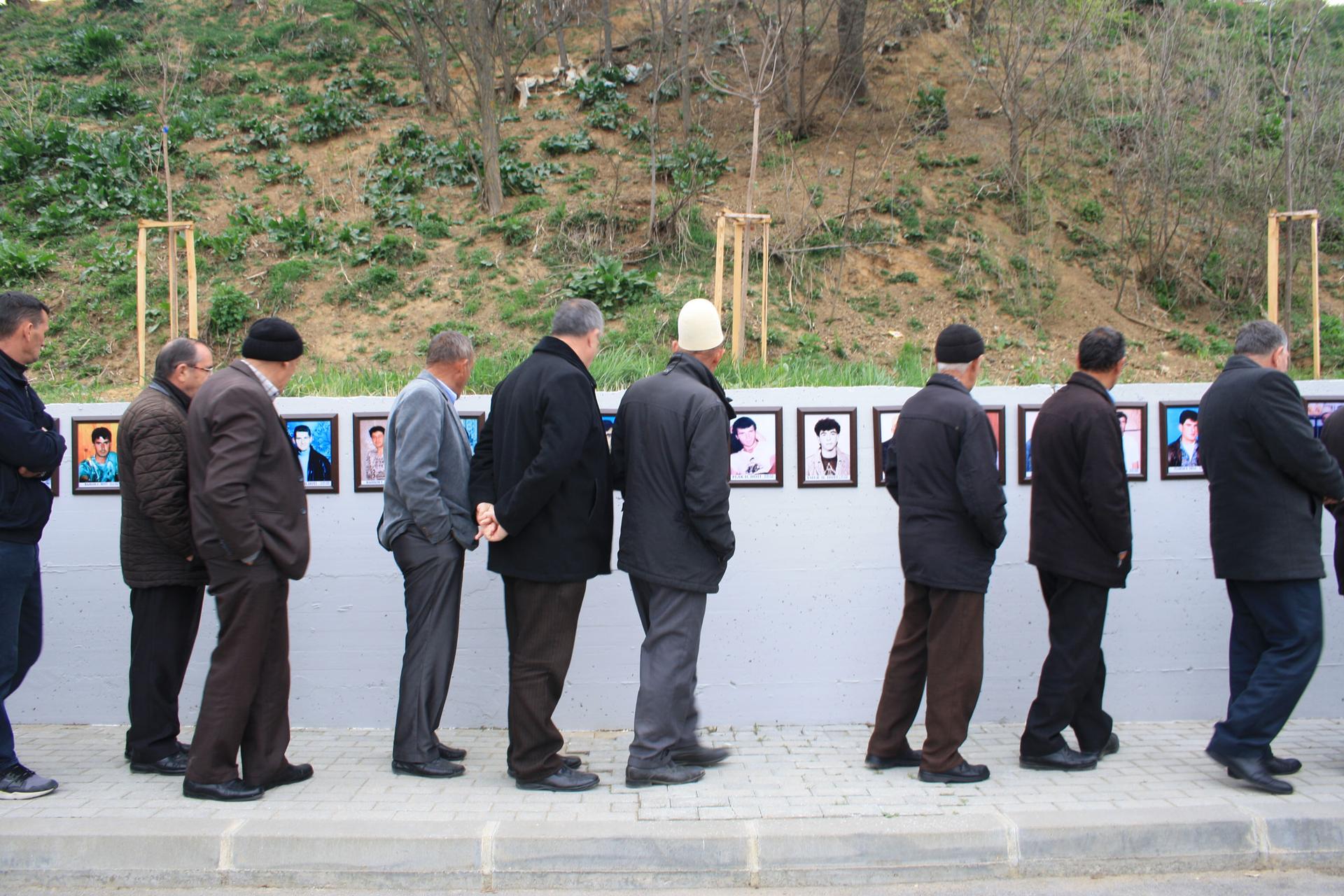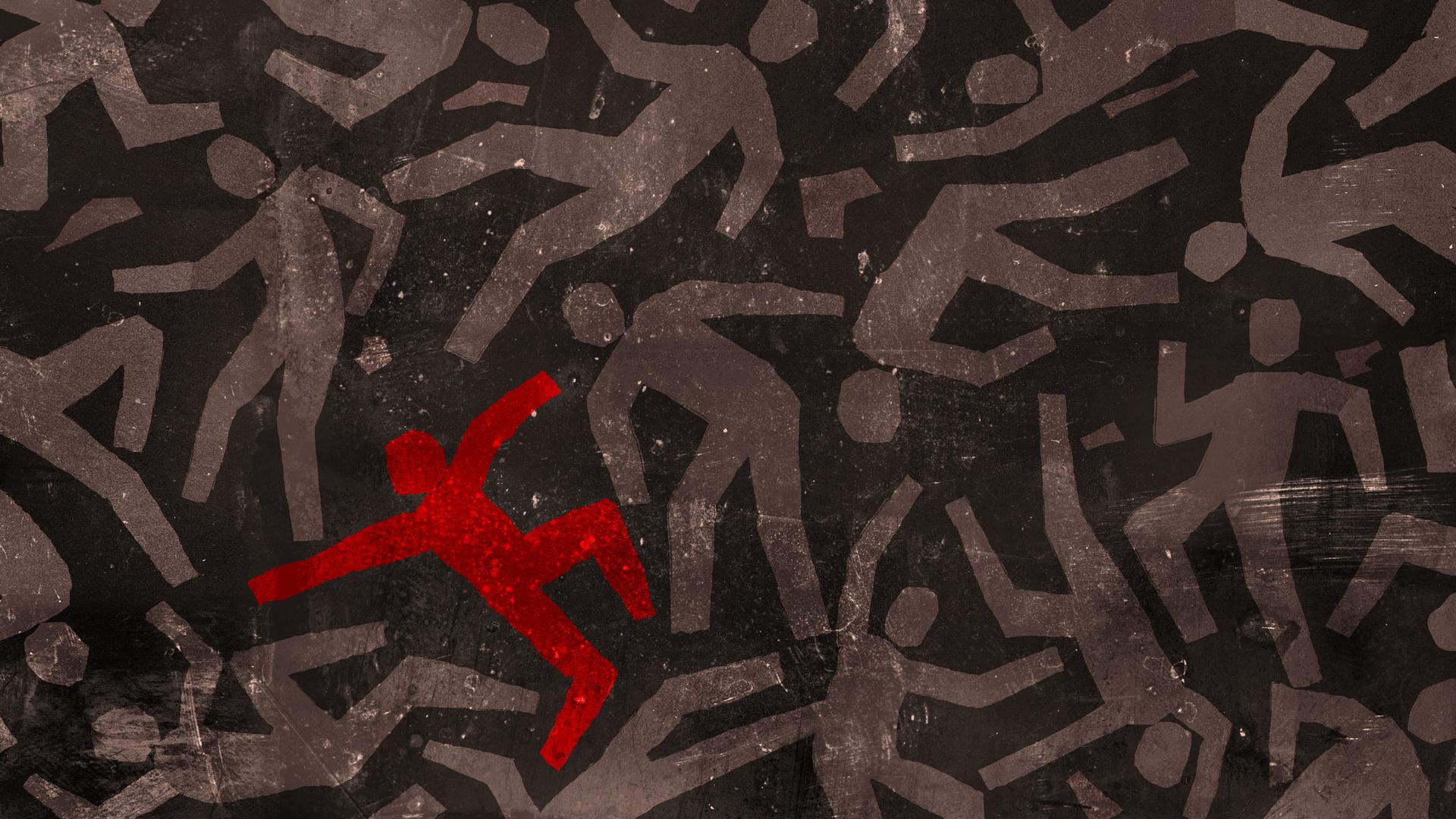The Nalli house was crowded. Just a few days before the 20th anniversary of the massacre in Velika Kruša in Kosovo, Valdete Nalli, the youngest daughter, busily set the table to eat flia, a dish that her mother prepared especially for her only surviving son, Binak Nalli.
Each year on March 26, the whole village congregates at the memorial cemetery to commemorate the 241 ethnic Albanian civilians — mostly men and boys — who were killed in 1999 during the Kosovo War when Serb forces stormed the village in western Kosovo.
Related: 20 years later, a genocide conviction for architect of the war in Bosnia
The Nalli family is honoring Binak’s twin brother, Shaban Nalli, and older brother, Besim Nalli, who were killed during the massacre and buried in unmarked mass graves. They are also gathering to remember the youngest son, Agim, a Kosovo Liberation Army fighter who died in combat.
“He’s the only brother that we found the entire body, usually you don’t find all the parts,” says 40-year-old Valdete Nalli. “For us, this was something good, that our youngest brother was in one piece.”
DNA-based identification methods have made it possible for thousands of families in the western Balkans to recover and identify the skeletal remains of their loved ones. But the wait — and new discoveries — has taken a devastating toll on families, even after they successfully identify missing relatives.
Related: There is one place where Serbs and Albanians coexist in Kosovo — in the country’s version of Costco
For years, the remains of dead relatives were recovered, fragmented and commingled from secondary mass graves. Perpetrators often reburied the remains after disturbing the primary gravesite in an attempt to hide their crimes, which complicates individual identification and reassociation of remains.
The DNA-based identification project in the Western Balkans is one of the largest of its kind in the world. While these discoveries may offer relief, it often distresses and retraumatizes families who have waited over 20 years for answers.
An estimated 35,000 people went missing as a result of armed conflicts in the former Yugoslavia in the 1990s, according to the International Committee of the Red Cross (ICRC).

To date, 24,914 had been identified and 10,090 are still unaccounted for, according to the ICRC. Before 2001, when the International Commission on Missing Persons (ICMP) introduced large-scale DNA testing at their lab in The Hague, identifications were made using traditional methods such as the visual identification of remains and belongings, which runs a significant risk of error.
“When the DNA method was introduced, the families remained skeptical about the process. To accept one or two bones as your kidnapped, killed son is the most difficult decision parents have to make, so they choose to believe their sons are still alive.”
“When the DNA method was introduced, the families remained skeptical about the process,” said Ivana Kostic from ICRC, who has been working with families of the missing in Serbia. “To accept one or two bones as your kidnapped, killed son is the most difficult decision parents have to make, so they choose to believe their sons are still alive.”
The success of DNA testing depends on the acceptance of the identification by the family of the missing, and mistakes in the past have impacted the key relationship between forensic institutions and surviving families.
Some, unwilling to only bury small pieces of bone, decide to wait for additional remains, while others are simply not ready to accept the results.
‘I will not accept one bone’
In the northern Bosnian city of Tuzla, a woman named Ema, who requested anonymity to protect her personal safety, said she refuses to accept the remains —a small bone from the foot— of her missing husband, with the strong belief that he could live without a foot and therefore still be alive.
“Could I accept that just a little tiny bone is found? I don’t agree with that and will never accept it. They [ICMP] want to force me to bury it. For them, it’s only important to finish and close the case.”
“Could I accept that just a little tiny bone is found? I don’t agree with that and will never accept it. They [ICMP forensic institute]want to force me to bury it. For them, it’s only important to finish and close the case,” Ema said.
The ICMP has assisted governments to locate, recover and identify missing persons and established state-level forensic institutions to sustain the process over the long term. The national authorities in Bosnia and Herzegovina, Serbia and Kosovo send postmortem biological samples to the ICMP DNA laboratory in The Hague, which seeks to match them against DNA profiles obtained from the families’ reference samples.
“For the entire former Yugoslavia, ICMP has collected nearly 100,000 reference samples from families of the missing,” said Sasa Kulukcija, ICMP’s press officer. “By comparing them with DNA profiles it has obtained from postmortem samples, ICMP has been able to DNA match more than 18,000 missing persons from conflicts in the former Yugoslavia.”
In Bosnia and Herzegovina, there are 11 local mortuaries where exhumed human remains are examined and processed by domestic forensic pathologists. “Still, there is a lack of standardized procedures on forensic work and overall institutionalized forensic capacities on the national level,” said Elmir Camić, head of the ICRC delegation in Bosnia.
Petra Kostic, now 80 (no relation to Ivana Kostic from ICRC) also rejects the DNA results of her sons, Lazar Kostic and Todor Kostic, even though her daughters accepted and proceeded with the reburial.
On the outskirts of the Serbian capital of Belgrade, Petra Kostic sat with her back to the two framed portraits of her sons that hang from the wall. She seemed withdrawn and showed signs of early dementia, but as soon as she heard the name of her sons, her eyes lit up and tears began to flow effortlessly.
“I’m still hoping they are alive somewhere. … I will not accept one bone.”
“I’m still hoping they are alive somewhere,” said Petra Kostic, releasing a deep breath. “I will not accept one bone.”
In 2006, the ICMP laboratory in Tuzla informed Petra Kostic’s daughter, Olgica Kostic, that two to three bones belonging to Lazar and Todor had been found. Despite her mother’s rejection, Olgica Kostic and her sisters buried their brothers’ found remains on Oct. 14 in the Orlovača cemetery in Belgrade.
“We cannot soften her pain. She can’t get over it,” Olgica Kostic said. “She’s waiting for them to be alive.”
Denial or peace
Accepting a loved one in the form of just one small piece of bone can provoke denial, but it can also bring a long-awaited peace.
Nura Begović, vice president of the Women of Srebrenica Association in Tuzla, buried her missing brother in July 2019 in the Srebrenica-Potočari Memorial and Cemetery, 24 years after approximately 8,000 Bosnian Muslim refugees were systematically killed in the United Nations safe zone.
“From all his body, I just found a hand and I accepted it.”
“From all his body, I just found a hand and I accepted it,” Begović said. “My husband is a witness [to the killing] and in 2005, [he] told me about the location where my brother was killed and this year, we identified him. Not only with DNA, but also with his belongings … His watch, house keys, sports pants, one of his shoes, and something else, but I couldn’t recognize what it was.”
Elmir Ibralic, a psychologist working with Vive Žene, a nongovernmental organization established during the war to provide psychosocial support to survivors in northeastern Bosnia, explains that for families of the missing, the process of mourning is very hard after years of hanging on to the possibility of their loved ones still being alive. Survivors live with anxiety, depression and uncertainty.
“Many of them have exhausted all the coping mechanisms and resources for healing. They’re frozen in the past, and can’t start a mourning process,” Ibralic said. “The second thing is the individual trauma of the war. They all have personal traumas.”
Burials, postponed
In 2004, the ICMP and ICRC told Valdete Nalli that the remains belonging to her missing brothers, Shaban Nalli and Besim Nalli, had been found. She remained seated in a village building, numbed by the answer she had been waiting on for years.
The burial was postponed until all the bones recovered in that mass grave were analyzed.
“They were killed and then burned,” Valdete Nalli said. “A part of the remains was found in a massive grave at the end of the woods — outside of the village — and the other group was found in a hole in a graveyard in the village.”
In an attempt to protect her family from further trauma, Valdete Nalli only shared progress on the case with her living brother, Binak Nalli, who lives in Switzerland, to support his family and the wives of his missing brothers with remittances.
After two years — which Valdete Nalli described as deeply traumatic — Shaban Nalli and Besim Nalli’s remains were finally buried in 2006, along with over 40 people who were in the same grave.
The Institute of Forensic Medicine (IFM) in Pristina, the capital of Kosovo, still holds 300 unidentified remains that don’t match with the blood samples from 2,900 families, according to Arsim Gerxhailu, IFM’s director.Organizations like ICMP and IFM are trying to review identifications made without DNA matching, but for many families, this implies reliving a process that never healed.
“We need to make a strategy and we need to go back to the more than 6,000 cases. [The] first step is to take blood from the families —6,000 families … and compare it to the 300 mortal remains here,” Gerxhailu told The World. “The biggest problem is that families are dying.”
Just when Valdete Nalli thought the process had ended, forensic experts contacted her five years later in 2009 and told her that more bones from her brothers had been found.
Then, in 2016, more bones belonging to Shaban Nalli were identified.
“Every six months they kept calling me. I couldn’t think of anything else, thinking that parts of their bodies are still outside, still not resting in peace…For Albanians, if you’re not inside the grave, that person is still not resting in peace.”
“Every six months they kept calling me. I couldn’t think of anything else, thinking that parts of their bodies are still outside, still not resting in peace … For Albanians, if you’re not inside the grave, that person is still not resting in peace,” Valdete Nalli explained.
“Three years ago, they said, ‘OK, this is the last pile. We are not going to call you anymore.’”
This reporting was supported by the International Women’s Media Foundation’s Reporting Grants for Women’s Stories.
We’d love to hear your thoughts on The World. Please take our 5-min. survey.
